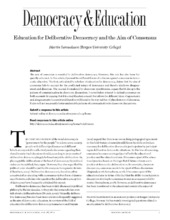| dc.contributor.author | Samuelsson, Martin | |
| dc.date.accessioned | 2019-06-28T09:01:00Z | |
| dc.date.available | 2019-06-28T09:01:00Z | |
| dc.date.issued | 2018 | |
| dc.identifier.issn | 1085-3545 | |
| dc.identifier.uri | https://hdl.handle.net/1956/20509 | |
| dc.description.abstract | The aim of consensus is essential to deliberative democracy. However, this aim has also been frequently criticized. In this article, I present two different forms of criticism against consensus in democratic education. The first, articulated by scholars of education for democracy, claims that the aim of consensus fails to account for the conflictual nature of democracy and thereby disallows disagreement and dissensus. The second, formulated by classroom practitioners, argues that it disrupts the pattern of communication in classroom discussions. I nevertheless attempt to defend consensus on both accounts by arguing that it is a multifaceted concept that allows for different types of agreements and disagreements to coexist and therefore will stand in the way neither of pluralism nor of dissensus. It also will not necessarily foster undesirable patterns of communication in classroom discussions. | en_US |
| dc.language.iso | eng | eng |
| dc.publisher | Lewis & Clark Graduate School of Education and Counseling | eng |
| dc.relation.ispartof | <a href="http://hdl.handle.net/1956/20510" target="blank"> Education for Deliberative Democracy. Theoretical assumptions and classroom practices</a> | |
| dc.title | Education for Deliberative Democracy and the Aim of Consensus | eng |
| dc.type | Peer reviewed | |
| dc.type | Journal article | |
| dc.description.version | publishedVersion | |
| dc.rights.holder | Copyright Democracy and Education | eng |
| dc.source.articlenumber | 2 | |
| dc.identifier.cristin | 1582669 | |
| dc.source.journal | Democracy and Education | |
| dc.source.40 | 26 | |
| dc.source.14 | 1 | |
